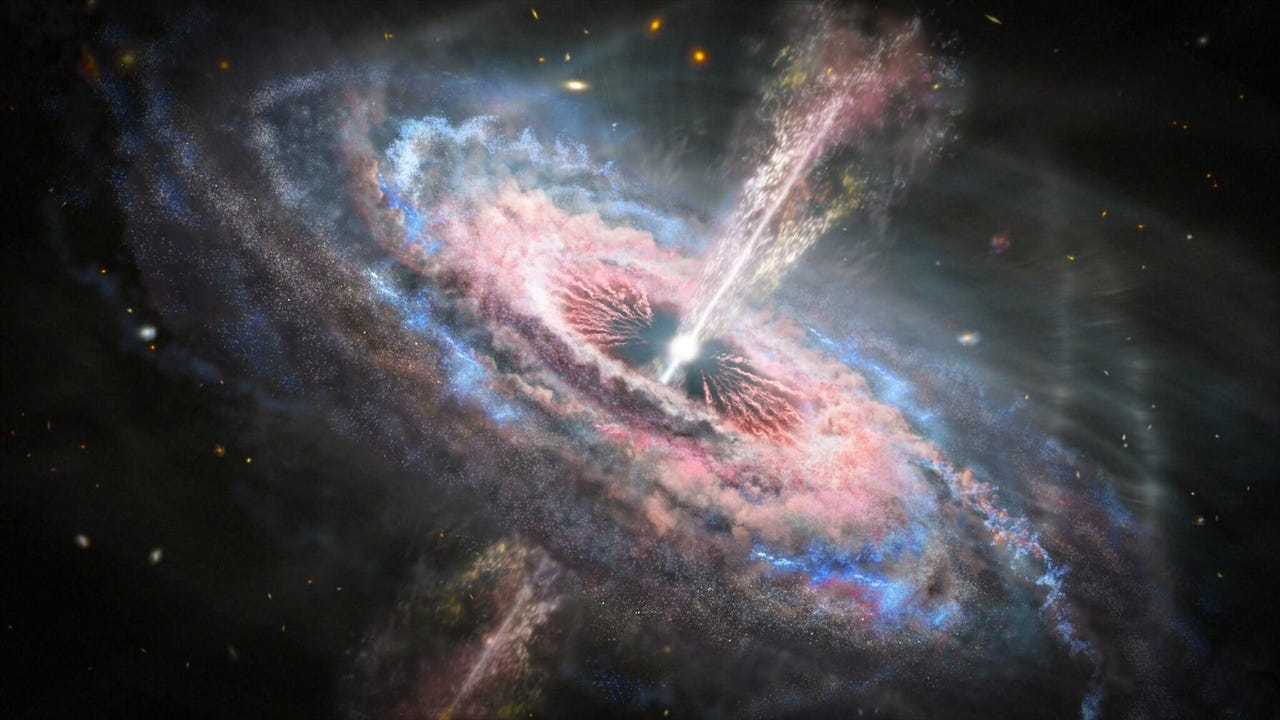
































This is an artist's concept of a galaxy with a brilliant quasar at its center. Using the unique capabilities of Webb, scientists will study six of the most distant and luminous quasars in the universe.
Image: NASA, ESA and J. Olmsted (STScI)On July 12, the world will have a new perspective of the universe, when the James Webb Space Telescope (JWST) mission releases its first set of full-color images as well as spectroscopic data. One of the photos to be released is the deepest image of our universe that has ever been taken, NASA Administrator Bill Nelson told reporters on Wednesday.
"This is farther than humanity has ever looked before," Nelson said, calling the telescope "nothing short of a real scientific feat."
The JWST was launched in December from Europe's Spaceport in Kourou, French Guiana, as part of an international program between NASA, the European Space Agency, and the Canadian Space Agency. Located 1 million miles away from Earth, the telescope was developed to study the evolution of our solar system.
SEE:NASA's Mars helicopter has a problem. This clever software trick could fix it
The photos that will be released were chosen for their spectacular color imagery, NASA said Wednesday, as well as to demonstrate the breadth of science that the JWST is supporting.
"We're only beginning to understand what Webb can and will do," Nelson said. "It's going to explore objects in the solar system and atmospheres of exoplanets orbiting other stars -- giving us clues as to whether their atmospheres are similar to our own. It may answer some questions that we have. Where do we come from? What more is out there? Who are we?"
Each image released next month will reveal different aspects of the infrared universe in unprecedented detail and sensitivity, scientists said Wednesday during a news conference.
Along with the deepest infrared view of the cosmos to date, the images also will show how galaxies interact and grow. Webb can reveal, for example, how cataclysmic collisions drive the process of star formation, with new, young stars emerging from their natal cloud of gas and dust. The telescope's images could also show dying stars seeding the galaxy with new elements and new dust that may one day become part of new planetary systems.
The images released on July 12 also will include the first spectrum of an exoplanet. NASA has confirmed the existence of more than 5,000 planets beyond our solar system, and looking at the vibrational spectrum of one could help us understand what molecules exist in its atmosphere -- and whether the exoplanet could potentially support life.
"We know that, of course, atmospheres reflect the make of the exoplanet," said Thomas Zurbuchen, associate administrator for NASA's Science Mission Directorate. "We know on Earth the atmosphere really changed when bacterial life arose. Much of the atmosphere has been shaped by that -- CO2, for example, is an important component. ... We're looking forward to seeing the atmosphere of that specific planet, but many more because we're learning about planets in a way we've never seen before."
SEE:NASA delays its Psyche asteroid mission
While the images the JWST team will release on July 12 should be impressive, they only scratch the surface of what Webb will be able to reveal. While the Webb mission is supposed to last 10 years, NASA deputy administrator Pam Melroy said Wednesday there is enough excess fuel capability to last for 20 years.
"We will go deeper into the science because we have the opportunity to learn and grow, make new observations," she said. "This mission is going to be at the very center of NASA's astrophysics mission for decades to come."
Zurbuchen said that viewing the Webb images is an emotional experience.
"It's an emotional moment when you see nature suddenly releasing some of its secrets," he said. "It's not an image. It's a new world view that you're going to see. Nature giving up secrets that have been there for many decades, centuries, millennia."
 Tags quentes :
Inovação
Espaço
Tags quentes :
Inovação
Espaço